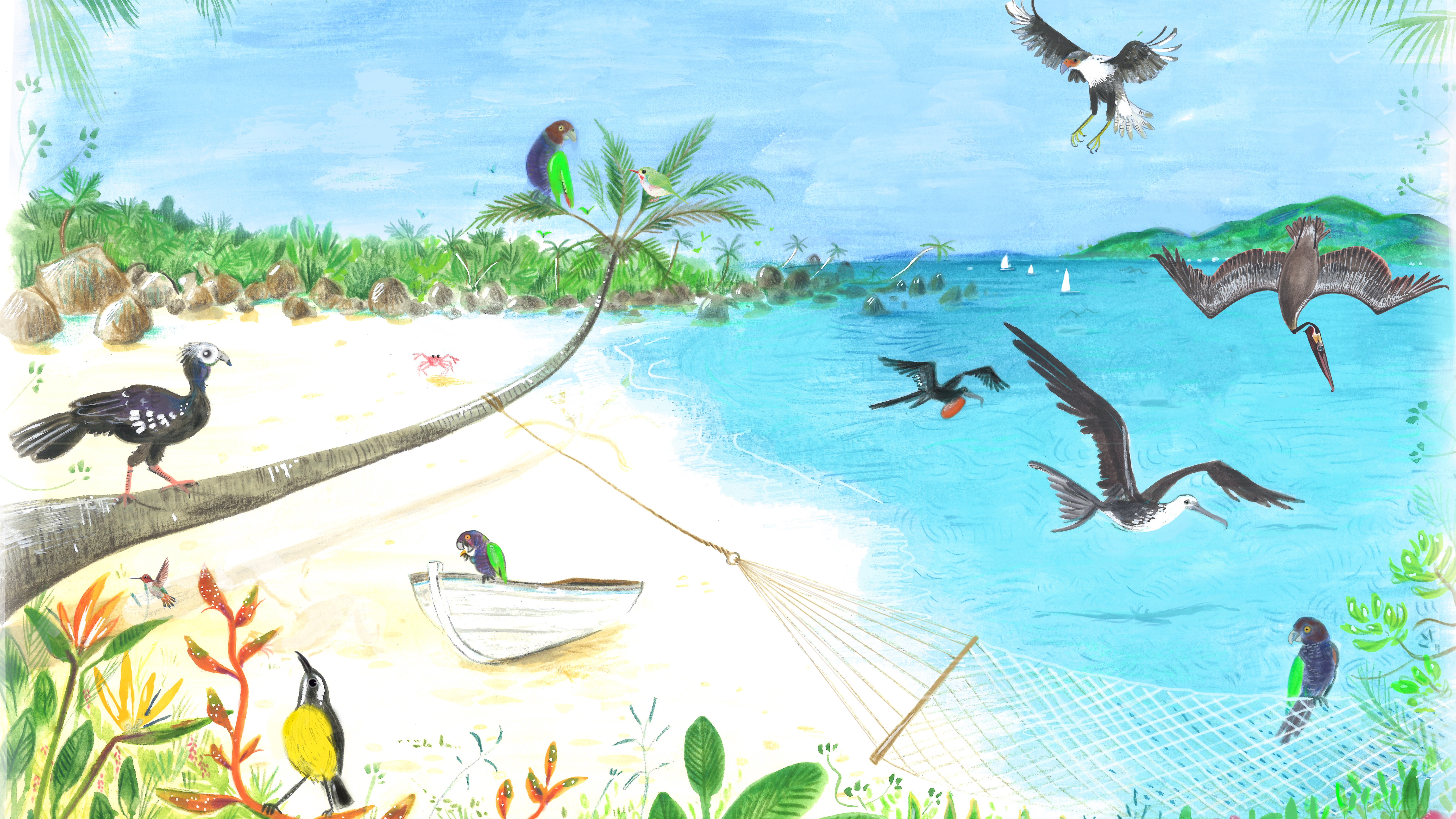From the Caribbean with love: The other James Bond who wrote the definitive guide to tropical birds
The Caribbean plays host to a brilliant spectrum of colourful avians, says John Lewis-Stempel, as he revels in a birdwatcher’s paradise. Illustrations by Annabelle King.


The name was Bond, James Bond. Bond was an American ornithologist whose name was borrowed by Ian Fleming, a twitcher himself, for his spy hero 007. The original Bond possesses another fame, being author of Birds of the West Indies. First published in 1936, this was, and is, the definitive guide to birds of the Caribbean. Yet even Bond’s knowledge and the artistry of the illustrators, struggles to pin to the page the beauty and variety of the birds that inhabit the tropical waters, islands and continental land masses framing the Caribbean Sea.
The Caribbean is a birder’s paradise, not merely for its birdy bounty, but for the singularity of its avifauna. Of the 700 or so species in the Caribbean, 185 are endemic and found nowhere else in the world. Of these endemic birds, 110 Caribbean birds are specific to one island and one island only. Ridgway’s hawk (Buteo ridgwayi) can only be found in Hispaniola and the Guadeloupe woodpecker (Melanerpes herminieri) is absolutely Guadeloupian. A place of azure seas and emerald rainforest, the Caribbean seemingly naturally produces birds of colourful exoticism, such as the red-legged honeycreeper (Cyanerpes cyaneus), whose brilliant pins are even outdone by its electric-blue plumage.
Yet the Caribbean has its subtleties, too. The grey Grenada dove (Leptotila wellsi) is almost weepingly fragile, the call of the St Vincent wren (Troglodytes musicus) is a lilting lyricality. One of the most famous songs of the Caribbean is Yellow Bird, about a yellow warbler (Setophaga petechia) in a banana tree. The bird is an emblem of love. Who could not love the birds of the Caribbean?
Magnificent frigatebird (Fregata magnificens)
See a magnificent frigatebird overhead and you can be forgiven for thinking you have wandered into Jurassic Park. With its dark angularities and deeply forked tail, it’s a dead ringer for a pterodactyl. The seabird also has prehistoric eating etiquette, piratically stealing food from other birds in midair — its old moniker of ‘man-o-war bird’ refers to this harassing habit. Full marks for the youthful pickpocketing practice: juvenile frigatebirds place sticks in their beaks and chase each other. When one drops a stick, its play pal dives below to retrieve it.
The male of the species has a bright red pouch under the throat, which it inflates like a balloon to attract a mate. Whether this puffed-up self-importance is genuinely alluring may be a moot point. The female Fregata magnificens looks nothing like the male, having a white breast and belly, as if embarrassed to be related, although neither sex will win the ‘Early Bird Prize’ as frigatebirds don’t generally take to the air until afternoon, when the thermals are a-rising.
West Indian whistling-duck (Dendrocygna arborea)

The West Indian whistling-duck eschews the regulation quack in favour of a shrill, haunting whistle.
Why is it called a whistling duck? Because it whistles. Obviously. Rather than a ducky quack, Dendrocygna arborea emits a shrill haunting s-h-i-r-i-r-i-a, hence its onomatopoeic Spanish name, suirirí. Despite being almost goose-sized, the duck can be hard to spot: it’s brown, hides by day and feeds at night. The ‘woodinesses’ of its scientific name point to its other secretive manners, which are to perch and nest in trees, especially within inaccessible swamps and mangroves. It is also unfortunately rare, although there is hope of population stabilisation due to conservation efforts.
Imperial Amazon (Amazona imperialis)
Who’s a pretty boy (and girl) then? The Imperial Amazon is a striking purple and green parrot and a proper national treasure, being Dominica’s national bird, portrayed on flag and coat of arms. Restricted in the wild to the wet montane rainforest of Morne Diablotin, the Imperial, known locally as the sisserou, may grow very long in the beak, reaching 70-plus years in captivity, often along-side its lifelong partner.
Exquisite houses, the beauty of Nature, and how to get the most from your life, straight to your inbox.
The largest parrot in the Amazon genus, the Imperial’s wingspan is a shadow-casting 76cm. Tragically, the bird’s numbers are in inverse proportion to its physical size. There may be fewer than 60 surviving adults. Tree-felling hurricanes are a major threat to its existence. A single hurricane, Maria in 2017, left only 12 sisserou alive.
Brown pelican (Pelecanus occidentalis)

When the huge brown pelican belly flops into the sea in search of fish, it is protected on impact by the avian equivalent of an airbag on its breast.
Absolutely beige and widespread throughout the region, the brown pelican is avian wallpaper. Well, until its ginormous form (wingspan 2.2m) cranks up into the air, gains altitude, reaches 18m and then plunges headfirst into the sea in search of fishy things. The charitable might call the action a ‘dive’, the realist would say it was the birdy form of a belly flop. Elegant it ain’t. However, a clever adaptation protects the brown pelican from serious impact injury: it has airbags on its breast. Despite the body-banging, brown pelicans are not bird-brained: they learn that entering the water at steep angles of 60–90 degrees reduces aiming errors caused by the distortion of light refracting through water.
Even their gular pouch, located under the beak, plays a role. As a celebrated limerick jests, ‘a remarkable bird is a pelican/Its beak can hold more than its belly can…’ True enough. The pouch, as the bird enters the water, expands immediately to be both fishing net and parachute, the latter slowing the bird down. That pouch can hold two gallons of water/fish.
Unsurprisingly, pelicans have changed little over 30 million years. After all, if it ain’t broke, don’t fix it.
Bananaquit (Coereba flaveola)
This is a sweet little bird, or perhaps a little bird keen on sweets. The hyperactive songbird drinks nectar by piercing flower bases with its sharp, decurved bill. Emboldened individuals — which seem to be the majority of the species — will purloin sugar from human tables.
Local names are as colourful as the warbler-sized bird: its Dutch name is suikerdiefje or ‘sugar thief’. One of the veritably characteristic birds of the Caribbean, the bananaquit is oddly and largely absent from the largest island, Cuba.
Bee hummingbird (Mellisuga helenae)

The miniscule bee hummingbird is the world’s smallest bird.
Wish to see the world’s tiniest bird? Then you’ll need to jump on a jet plane to Cuba. The bee hummingbird, which is found only on said Caribbean island, is an exquisite minikin, even among the perfect jewelled miniatures that are hummingbirds.
Placed against a ruler it measures only 5cm. Put on scales, it registers a barely perceptible 2g. Bee hummingbirds are frequently mistaken for, wait for it… bees. The female’s eggs are the size of a hazelnut.
A supremely alive little thing, all vital force and electricity. In quotidian flight, the tiny fairy wings beat 80 times a second. During courtship flight, the wings whirr at 200 times a second — which would be a sight to see, if only human eyes were capable of registering it.
Trinidad piping guan (Aburria pipile)
Let’s talk turkey, or at least the turkey-looking Trinidad piping guan, whose eponymous whistling call echoing around the lush rainforest is always a reminder that Caribbean birds are to be heard and not simply seen. For communication, this rare arboreal member of the family Cracidae (which includes the chachalaca, guan and curassow) also ‘drums’, clapping its wings as it glides between trees.
Courtship rituals are extravagant, with the male crest-raising, vocalising and shaking its tail feathers. The pattern of white markings on the wings is unique to each individual bird. Historically, hunting contributed to the precipitous decline of the pawi, as the bird is known locally, as the 60cm target was a sitting turkey. Hopefully, pawi-focused ecotourism tours now make the bird more valuable alive than dead.
The Northern crested caracara (Caracara plancus)
This bird looks like a vulture, but it’s actually a falcon. A falcon, that is, which prefers to scavenge (very vulturely) on foot and will eat fruit. The bird’s confusing ways are matched by its mismatched appearance: the vulture face, the leggy legs made for walking and the air of nobility when in the air despite its terra firma opportunistic habits (some cultures ascribe the caracara the title ‘eagle’).
The caracara is the only falcon known to collect its own nesting materials, the rest of the zoological order sequestering existing premises. ‘Caracara’ probably derives from the rattling noise when agitated.
The species breeds in the Dutch Caribbean, with populations in Curaçao rebounding over the past 30 years after almost disappearing. Good. Nature needs its Caribbean eccentricities.
Scaly-naped pigeon (Patagioenas squamosa)

The scaly-naped pigeon earns its name from the deceptive arrangement of feathers at its neck.
By preference, this bird is a denizen of the rainforest, where it performs an invaluable role in the ecosystem by dispersal of fruit and tree seeds.
In many islands, it is notably wary, possibly an evolution due to hunting pressures and if glimpsed it will be in the tree top peering down suspiciously. The pigeon’s calls, together with a very dovey coo-coo, even seem to include the line ‘who’re you?’ A successful approach allows a slow reveal of its beauty, the bird transforming from slate grey into iridescent mauve; the eponymous scaly nape is a particular mirage, due to the arrangement of the feathers rather than presence of flesh (‘squamosa’, by the way, means scaly). There are islands, however, where the pigeon deigns to mix with humans, even in the urban environment. The Grenadines are among them.
The Jamaican Tody (Todus todus)
Endemic to Jamaica, this cute, if hallucinogenic, puffball sails under the apposite nickname of ‘rasta bird’. Its brilliant red, green and yellow mirror-match the Rastafarian flag. Another local cognomen, ‘Jesus bird’, derives from the legend that during Christ’s crucifixion a drop of blood fell onto the bird as it gazed up at the cross.
Curiously, for a perching bird, it digs a burrow to nest in and may generously share its underground accommodation with lizards and mice. Its toiletry is also noteworthy, the bird suddenly midair diving into water for a quick bath.
Generally, it is a quiet bird, except in the breeding season when it positively beeps and rattles. A dedicated insectivore — regard the thin tweezer bill — it is an esteemed pest-control operative in the coffee farms of the Blue Mountains.
This feature originally appeared in the October 22, 2025, issue of Country Life. Click here for more information on how to subscribe.
